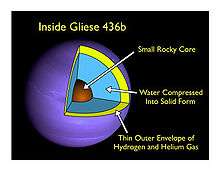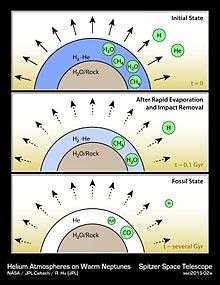Gliese 436 b
Gliese 436 b /ˈɡliːzə/ (sometimes called GJ 436 b[5]) is a Neptune-sized exoplanet orbiting the red dwarf Gliese 436.[6] It was the first hot Neptune discovered with certainty (in 2007) and was among the smallest-known transiting planets in mass and radius, until the much smaller Kepler exoplanet discoveries began circa 2010.
 Size comparison of Gliese 436 b with Neptune | |
| Discovery | |
|---|---|
| Discovered by | Butler, Vogt, Marcy et al. |
| Discovery site | California, USA |
| Discovery date | August 31, 2004 |
| Radial velocity, Transit | |
| Orbital characteristics | |
| 0.028±0.01 AU | |
| Eccentricity | 0.152+0.009 −0.008[1] |
| 2.643904±0.000005[2] d | |
| Inclination | 85.8+0.21 −0.25[2] |
| 2451552.077[1] | |
| 325.8+5.5 −5.7[1] | |
| Semi-amplitude | 17.38±0.17[1] |
| Star | Gliese 436 |
| Physical characteristics | |
Mean radius | 4.327±0.183[3][4] R⊕ |
| Mass | 21.36+0.20 −0.21[1] M⊕ |
Mean density | 1.51 g/cm3 (0.055 lb/cu in) |
| 1.18 g | |
| Temperature | 712±36 K[3] |
In December 2013, NASA reported that clouds may have been detected in the atmosphere of GJ 436 b.[7][8][9][10]
Discovery
Gliese 436 b was discovered in August 2004 by R. Paul Butler and Geoffrey Marcy of the Carnegie Institute of Washington and University of California, Berkeley, respectively, using the radial velocity method. Together with 55 Cancri e, it was the first of a new class of planets with a minimum mass (M sini) different to Neptune.
The planet was recorded to transit its star by an automatic process at NMSU on January 11, 2005, but this event went unheeded at the time.[11] In 2007, Gillon led a team that observed the transit, grazing the stellar disc relative to Earth. Transit observations led to the determination of its exact mass and radius, both of which are very similar to that of Neptune, making Gliese 436 b at that time the smallest known transiting extrasolar planet. The planet is about four thousand kilometers larger in diameter than Uranus and five thousand kilometers larger than Neptune and slightly more massive. Gliese 436b orbits at a distance of four million kilometers or one-fifteenth the average distance of Mercury from the Sun.
Physical characteristics


The planet's surface temperature is estimated from measurements taken as it passes behind the star to be 712 K (439 °C; 822 °F).[3] This temperature is significantly higher than would be expected if the planet were only heated by radiation from its star, which was prior to this measurement, estimated at 520 K. Whatever energy tidal effects deliver to the planet, it does not affect its temperature significantly.[12] A greenhouse effect could raise the temperature to much higher degrees than the predicted 520–620 K.[13]
In 2019, USA Today reported that the exoplanet's burning ice continued to have scientists "flabbergasted."[14] Its main constituent was initially predicted to be hot "ice" in various exotic high-pressure forms,[13][15] which would remain solid despite the high temperatures, because of the planet's gravity.[16] The planet could have formed further from its current position, as a gas giant, and migrated inwards with the other gas giants. As it arrived in range, the star would have blown off the planet's hydrogen layer via coronal mass ejection.[17]
However, when the radius became better known, ice alone was not enough to account for it. An outer layer of hydrogen and helium up to ten percent in mass would be needed on top of the ice to account for the observed planetary radius.[3][2] This obviates the need for an ice core. Alternatively, the planet may be a super-earth.[18]
Observations of the planet's brightness temperature with the Spitzer Space Telescope suggest a possible thermochemical disequilibrium in the atmosphere of this exoplanet. Results published in Nature suggest that Gliese 436b's dayside atmosphere is abundant in CO and deficient in methane (CH4) by a factor of ~7,000. This result is unexpected because, based on current models at this temperature, the atmospheric carbon should prefer CH4 over CO.[19][20][21][22] In part for this reason, it has also been hypothesized to be a possible helium planet.[23]
In June 2015, scientists reported that the atmosphere of Gliese 436 b was evaporating,[24] resulting in a giant cloud around the planet and, due to radiation from the host star, a long trailing tail 14×106 km (9×106 mi) long.[25]

Orbital characteristics
One orbit around the star takes only about two days, 15.5 hours. Gliese 436 b's orbit is likely misaligned with its star's rotation.[21] The eccentricity of Gliese 436 b's orbit is inconsistent with models of planetary system evolution. To have maintained its eccentricity over time requires that it be accompanied by another planet.[3][27]
A study published in Nature found that the orbit of Gliese 436 b is nearly perpendicular to the stellar equator of Gliese 436 and suggests that the eccentricity and misalignment of the orbit could have resulted from interactions with a yet undetected companion. The inward migration caused by this interaction could have triggered the atmospheric escape that sustains its giant exosphere.[28]
See also
- 55 Cancri e
- Gliese 581 b
- Gliese 876 d
- HAT-P-11b
References
- Trifonov, T.; et al. (2018). "The CARMENES search for exoplanets around M dwarfs. First visual-channel radial-velocity measurements and orbital parameter updates of seven M-dwarf planetary systems". Astronomy and Astrophysics. 609. A117. arXiv:1710.01595. Bibcode:2018A&A...609A.117T. doi:10.1051/0004-6361/201731442.
- Bean, J.L.; et al. (2008). "A Hubble Space Telescope transit light curve for GJ 436b". Astronomy & Astrophysics. 486 (3): 1039–1046. arXiv:0806.0851. Bibcode:2008A&A...486.1039B. doi:10.1051/0004-6361:200810013.
- Drake Deming; Joseph Harrington; Gregory Laughlin; Sara Seager; Navarro, Sarah B.; Bowman, William C.; Karen Horning (2007). "Spitzer Transit and Secondary Eclipse Photometry of GJ 436b". The Astrophysical Journal. 667 (2): L199–L202. arXiv:0707.2778. Bibcode:2007ApJ...667L.199D. doi:10.1086/522496.
- Confirmed, Pont, F.; Gilliland, R. L.; Knutson, H.; Holman, M.; Charbonneau, D. (2008). "Transit infrared spectroscopy of the hot neptune around GJ 436 with the Hubble Space Telescope". Monthly Notices of the Royal Astronomical Society: Letters. 393 (1): L6–L10. arXiv:0810.5731. Bibcode:2009MNRAS.393L...6P. doi:10.1111/j.1745-3933.2008.00582.x.
- Beust,Hervé; et al. (August 1, 2012). "Dynamical evolution of the Gliese 436 planetary system - Kozai migration as a potential source for Gliese 436b's eccentricity". Astronomy. 545: A88. arXiv:1208.0237. Bibcode:2012A&A...545A..88B. doi:10.1051/0004-6361/201219183.
- Butler, R. Paul; et al. (2004). "A Neptune-Mass Planet Orbiting the Nearby M Dwarf GJ 436". The Astrophysical Journal. 617 (1): 580–588. arXiv:astro-ph/0408587. Bibcode:2004ApJ...617..580B. doi:10.1086/425173.
- Harrington, J.D.; Weaver, Donna; Villard, Ray (December 31, 2013). "Release 13-383 - NASA's Hubble Sees Cloudy Super-Worlds With Chance for More Clouds". NASA. Retrieved January 1, 2014.
- Moses, Julianne (January 1, 2014). "Extrasolar planets: Cloudy with a chance of dustballs". Nature. 505 (7481): 31–32. Bibcode:2014Natur.505...31M. doi:10.1038/505031a. PMID 24380949.
- Knutson, Heather; et al. (January 1, 2014). "A featureless transmission spectrum for the Neptune-mass exoplanet GJ 436b". Nature. 505 (7481): 66–68. arXiv:1401.3350. Bibcode:2014Natur.505...66K. doi:10.1038/nature12887. PMID 24380953.
- Kreidberg, Laura; et al. (January 1, 2014). "Clouds in the atmosphere of the super-Earth exoplanet GJ 1214b". Nature. 505 (7481): 69–72. arXiv:1401.0022. Bibcode:2014Natur.505...69K. doi:10.1038/nature12888. hdl:1721.1/118780. PMID 24380954.
- Coughlin, Jeffrey L.; Stringfellow, Guy S.; Becker, Andrew C.; Mercedes Lopez-Morales; Fabio Mezzalira; Tom Krajci (2008). "New observations and a possible detection of parameter variations in the transits of Gliese 436b". The Astrophysical Journal. 689 (2): L149–L152. arXiv:0809.1664. Bibcode:2008ApJ...689L.149C. doi:10.1086/595822.
- Brian Jackson; Richard Greenberg; Rory Barnes (2008). "Tidal Heating of Extra-Solar Planets". The Astrophysical Journal. 681 (2): 1631–1638. arXiv:0803.0026. Bibcode:2008ApJ...681.1631J. doi:10.1086/587641.
- M. Gillon; et al. (2007). "Detection of transits of the nearby hot Neptune GJ 436 b" (PDF). Astronomy and Astrophysics. 472 (2): L13–L16. arXiv:0705.2219. Bibcode:2007A&A...472L..13G. doi:10.1051/0004-6361:20077799.
- https://www.usatoday.com/videos/tech/science/2019/03/27/exoplanet-thats-coated-burning-ice-probably-strangest-ever/3288764002/
- Shiga, David (6 May 2007). "Strange alien world made of "hot ice"". New Scientist. Archived from the original on July 6, 2008. Retrieved 2007-05-16.
- Fox, Maggie (May 16, 2007). "Hot "ice" may cover recently discovered planet". Science News. Scientific American.com. Retrieved 2008-08-06.
- H. Lammer; et al. (2007). "The impact of nonthermal loss processes on planet masses from Neptunes to Jupiters" (PDF). Geophysical Research Abstracts. 9 (7850). By analogy with Gliese 876 d.
- E. R. Adams; S. Seager; L. Elkins-Tanton (February 2008). "Ocean Planet or Thick Atmosphere: On the Mass-Radius Relationship for Solid Exoplanets with Massive Atmospheres". The Astrophysical Journal. 673 (2): 1160–1164. arXiv:0710.4941. Bibcode:2008ApJ...673.1160A. doi:10.1086/524925.
- Stevenson, KB; Harrington, J; Nymeyer, S; et al. (22 April 2010). "Possible thermochemical disequilibrium in the atmosphere of the exoplanet GJ 436b". Nature. 464 (7292): 1161–1164. arXiv:1010.4591. Bibcode:2010Natur.464.1161S. doi:10.1038/nature09013. PMID 20414304.
- GJ436b - Where's the methane? Archived 2010-05-14 at the Wayback Machine Planetary Sciences Group at the University of Central Florida, Orlando
- Knutson, Heather A. (2011). "A Spitzer Transmission Spectrum for the Exoplanet GJ 436b". Astrophysical Journal. 735, 27 (1): 27. arXiv:1104.2901. Bibcode:2011ApJ...735...27K. doi:10.1088/0004-637X/735/1/27.
- LINE, Michael R.; VASISHT, Gautam; CHEN, Pin; ANGERHAUSEN, D.; YANG, Yuk L. (2011). "Thermochemical and Photochemical Kinetics in Cooler Hydrogen Dominated Extrasolar Planets". Astrophysical Journal. 738, 32 (1): 32. arXiv:1104.3183. Bibcode:2011ApJ...738...32L. doi:10.1088/0004-637X/738/1/32., abstract in the arXiv titled "Thermochemistry and Photochemistry in Cooler Hydrogen Dominated Extrasolar Planets: The Case of GJ436b"
- "Helium-Shrouded Planets May Be Common in Our Galaxy". SpaceDaily. 16 June 2015. Retrieved 3 August 2015.
- D. Ehrenreich; V. Bourrier; P. Wheatley; A. Lecavelier des Etangs; G. Hébrard; S. Udry; X. Bonfils; X. Delfosse; J.-M. Désert; D. K. Sing; A. Vidal-Madjar (25 June 2015). "A Giant Comet-like Cloud of Hydrogen Escaping from the warm Neptune-mass Exoplanet GJ 436b". Nature. 522 (7557): 459–461. arXiv:1506.07541. Bibcode:2015Natur.522..459E. doi:10.1038/nature14501. PMID 26108854.
- Bhanoo, Sindya N. (25 June 2015). "A Planet with a Tail Nine Million Miles Long". New York Times. Retrieved 25 June 2015.
- "Hubble sees atmosphere being stripped from Neptune-sized exoplanet". Retrieved 25 June 2015.
- Bean, Jacob L.; Andreas Seifahrt (2008). "Observational Consequences of the Recently Proposed Super-Earth Orbiting GJ436". Astronomy & Astrophysics. 487 (2): L25–L28. arXiv:0806.3270. Bibcode:2008A&A...487L..25B. doi:10.1051/0004-6361:200810278.
- Bourrier, Vincent; et al. (2018). "Orbital misalignment of the Neptune-mass exoplanet GJ 436b with the spin of its cool star". Nature. 553 (7689): 477–480. arXiv:1712.06638. Bibcode:2018Natur.553..477B. doi:10.1038/nature24677. PMID 29258300.
Selected media articles
| Wikinews has related news: |
- How Do Artists Portray Exoplanets They've Never Seen? 4/9, Scientific American October 2, 2007.
- Astronomers Detect Shadow Of Water World In Front Of Nearby Star (from Science Daily).
External links
![]()